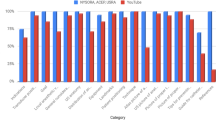Abstract
Aims
In a problem-based learning curriculum, most medical students research the Internet for information for their “learning issues.” Internet sites such as “YouTube” have become a useful resource for information. This study aimed at assessing YouTube videos covering surface anatomy.
Method
A search of YouTube was conducted from November 8 to 30, 2010 using research terms “surface anatomy,” “anatomy body painting,” “living anatomy,” “bone landmarks,” and “dermatomes” for surface anatomy–related videos. Only relevant video clips in the English language were identified and related URL recorded. For each videotape the following information were collected: title, authors, duration, number of viewers, posted comments, and total number of days on YouTube. The data were statistically analyzed and videos were grouped into educationally useful and non-useful videos on the basis of major and minor criteria covering technical, content, authority, and pedagogy parameters.
Results
A total of 235 YouTube videos were screened and 57 were found to have relevant information to surface anatomy. Analysis revealed that 15 (27%) of the videos provided useful information on surface anatomy. These videos scored (mean ± SD, 14.0 ± 0.7) and mainly covered surface anatomy of the shoulder, knee, muscles of the back, leg, and ankle, carotid artery, dermatomes, and anatomical positions. The other 42 (73%) videos were not useful educationally, scoring (mean ± SD, 7.4 ± 1.8). The total viewers of all videos were 1,058,634. Useful videos were viewed by 497,925 (47% of total viewers). The total viewership per day was 750 for useful videos and 652 for non-useful videos. No video clips covering surface anatomy of the head and neck, blood vessels and nerves of upper and lower limbs, chest and abdominal organs/structures were found.
Conclusions
Currently, YouTube is an inadequate source of information for learning surface anatomy. More work is needed from medical schools and educators to add useful videos on YouTube covering this area.
Similar content being viewed by others
References
Ache KA, Wallace LS (2008) Human papillomavirus vaccination coverage on YouTube. Am J Prev Med 35(4):389–392
Alexa Traffic Rank for YouTube (2011) http://www.alexa.com/siteinfo/youtube.com. Accessed 20 Mar 2011
Boulos MN, Maramba I, Wheeler S (2006) Wikis, blogs and podcasts: a new generation of web-based tools for virtual collaborative clinical practice and education. BMC Med Educ 6:41
Clifton A, Mann C (2010) Can YouTube enhance student nurse learning? Nurse Educ Today. doi:10.1016/j.nedt.2010.10.004
Huang C, Fu T, Chen H (2010) Text-based video content classification for online video-sharing sites. J Am Soc Inf Sci Technol 61(5):891–906
Keelan J, Pavri-Garcia V, Tomlinson G, Wilson K (2007) YouTube as a source of information on immunization: a content analysis. JAMA 298:2482–2484
Lillie SE (2008) Diffusion of innovation in the age of YouTube. Am J Prev Med 34:267
Lemley T, Burnham JF (2009) Web 2.0 tools in medical and nursing school curricula. J Med Libr Assoc 97(1):50–52
McConville SA, Lane AM (2006) Using on-line video clips to enhance self-efficacy towards dealing with difficult situations among nursing students. Nurse Educ Today 93:200–208
Pandey A, Patni N, Singh M, Sood A, Singh G (2010) YouTube as a source of information on the H1N1 influenza pandemic. Am J Prev Med 38(3):e1–e3
Skiba DJ (2007) Nursing education 2.0: YouTube. Nurs Educ Persp 28(2):100–102
Steinberg PL, Wason S, Stern JM, Deters L, Kowal B, Seigne J (2010) YouTube as source of prostate cancer information. Urology 75:619–622
USA Today (2006) YouTube serves up 100 million videos a day online. http://www.usatoday.com/tech/news/2006-07-16-youtube-views_x.htm. Accessed 8 Mar 2011
Conflict of interest
The author reports no conflict of interest. He is the only author of the paper.
Author information
Authors and Affiliations
Corresponding author
Rights and permissions
About this article
Cite this article
Azer, S.A. Can “YouTube” help students in learning surface anatomy?. Surg Radiol Anat 34, 465–468 (2012). https://doi.org/10.1007/s00276-012-0935-x
Received:
Accepted:
Published:
Issue Date:
DOI: https://doi.org/10.1007/s00276-012-0935-x




